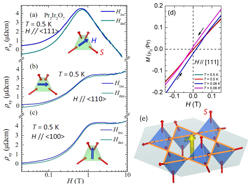Magnetic control of chiral domains in the chiral spin states of Pr2Ir2O7
Nakatsuji Group
Electronic transport under the influence of a background spin texture opened fundamental themes in physics, such as giant/colossal magnetoresistive effects, and the anomalous Hall-effect (AHE). These magnetotransport phenomena provided the conceptual basis for current research in spintronics and have so far been intensively investigated in ferromagnetic, transition metals, oxides, and semiconductors. The recent discovery of a chiral spin liquid in the metallic frustrated magnet Pr2Ir2O7 (refs.6, 7) through the AHE at zero magnetic field below 1.5 K, provides a unique laboratory for studying novel magnetotransport phenomena in the absence of magnetic dipole long range order [1-3].

Fig.1. Hall resistivity ρxy = Rxy •t, where t is the sample thickness, for a Pr2Ir2O7 single crystal, as a function of magnetic field H applied respectively along the (a) [111], (b) [110], and (c) [100] crystallographic directions and for T = 500 mK, respectively. These traces were measured for increasing (blue traces) and decreasing (gray traces) field scans. Notice how the hysteresis depends strongly on the orientation of the magnetic-field. (d) Magnetization as a function of H, for increasing and decreasing field scans, and respectively for T = 0.06 and 0.5 K. Notice the absence of hysteresis among the traces acquired at T = 0.5 K, but its presence in the Hall response acquired at the same temperature, as shown in (a). (d) A schematic picture to show the fictitious field K // [111], generating delocalized orbital currents within the [111] kagome planes, which are linearly coupled to the chiral order parameter breaking the parity and time-reversal invariance.
In this study, we uncover a strong anisotropy in both the AHE and the magnetoresistance of the chiral spin states observed in cubic single crystals of Pr2Ir2O7 [4]. Hysteresis in the AHE appearing below 1.5 K, is most pronounced when the magnetic field is cycled along the [111] direction, as shown in Fig. 1. This indicates that delocalized orbital currents generating an associated magnetic moment and which are linearly coupled to the chiral order parameter breaking the parity and time-reversal invariance, circulate within the [111] kagome planes. The hysteresis loop in the AHE characterizing the chiral spin state, closes at a metamagnetic transition critical field Bc observed only for fields along the [111] direction. These observations pose the intriguing possibility that Dirac magnetic monopoles and antimonopole, which are deconfined and interact through the magnetic Coulomb law in the classical dipolar spin ice, now have a finite quantum-mechanical average in the zero-field chiral spin-liquid state which is dominated by 2-in, 2-out spin-ice configurations. Above Bc and only for fields applied along the [111] direction, we observe a large positive magnetoresistance and Shubnikov de Haas oscillations. This suggests that densely populated magnetic monopoles and antimonopoles, reconstruct the electronic structure of the Ir conduction electrons in the basal kagome planes.
References
- S. Nakatsuji, Y. Machida, Y. Maeno, T. Tayama, T. Sakakibara, J. van Duijn, L. Balicas, J. N. Millican, R. T. Macaluso, and Julia Y. Chan, Physical Review Letters 96, 087204 (2006).
- Y. Machida, S. Nakatsuji, Y. Maeno, T. Tayama, T. Sakakibara, S. Onoda, Physical Review Letters 98, 057203 (2007).
- Y. Machida, S. Nakatsuji, S. Onoda, T. Tayama, T. Sakakibara, Nature 463, 210 (2010).
- L. Balicas, S. Nakatsuji, Y. Machida, and S. Onoda, Physical Review Letters 106, 217204 (2011).
